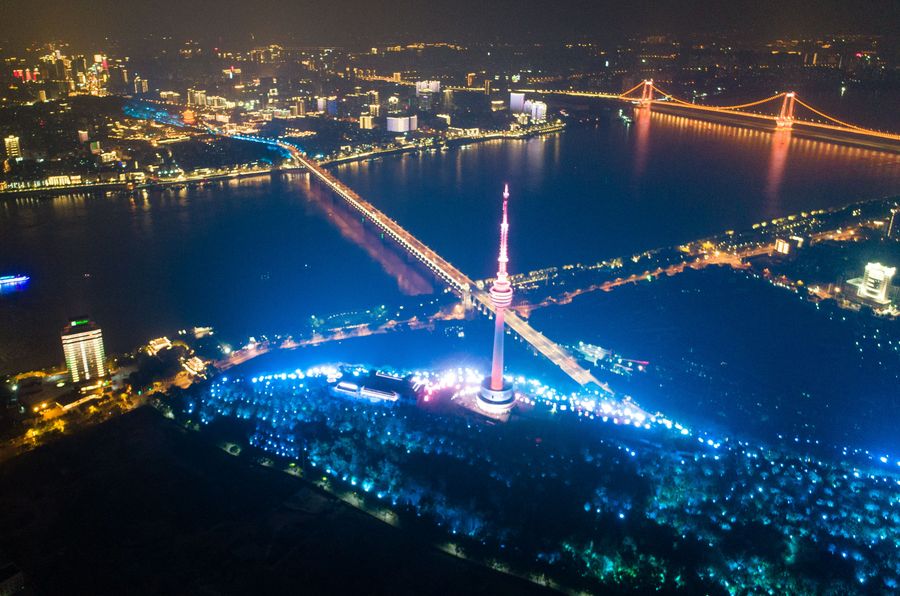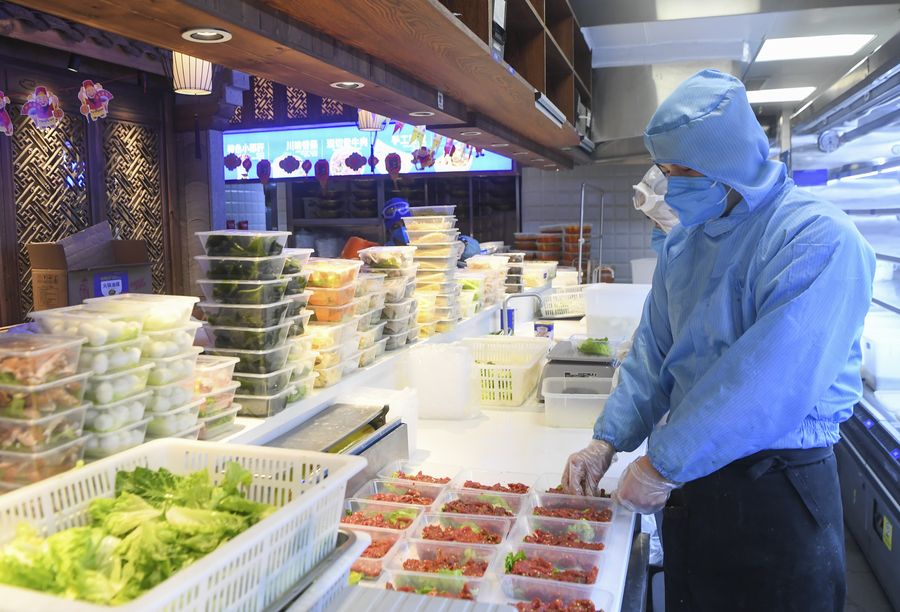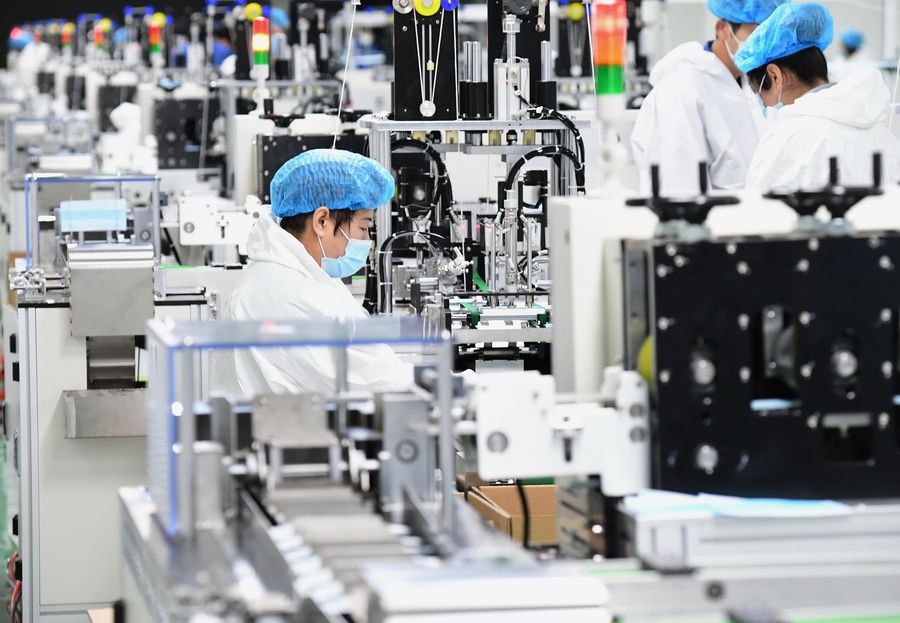China sees silver lining to 'quarantine economy'
The silver lining to a "quarantine economy" may not just illuminate the dark cloud of quarantines elsewhere but also shed light on the country's post-epidemic economic landscape.
As the spread of the coronavirus pandemic is far from being contained globally, sustaining normal life while businesses are under lockdown has become a challenge for many.

Aerial photo taken on April 7, 2020 shows a night view in Wuhan, central China's Hubei province. [Photo/Xinhua]
The economic consequences of quarantine could be upsetting as analysts forecast a recession for the world economy and policymakers are discussing whether or not to initiate coronavirus bailouts to remedy business halts and ward off loan defaults.
What's worse, the pandemic shows no signs of immediate easing, with the number of infections outside of China topping 1,190,000 as of 10 a.m. Central European Time, Tuesday, according to the World Health Organization.
At a time when Wuhan lifted its 76-day-long lockdown Wednesday, it is worth looking back at what Chinese have gone through during the unusual period. The silver lining to a "quarantine economy" may not just illuminate the dark cloud of quarantines elsewhere but also shed light on the country's post-epidemic economic landscape.
Go non-contact
When in quarantine, social distancing and self-isolation matter most. For households, that means inconvenience in meeting daily needs and changes to normal routines. On the business side, the challenges translate into customer losses, understaffing as well as protecting the health of staff and customers.
To survive the economic difficulties, Chinese businesses have invented various non-contact solutions to reduce contagion risks, in the hope of retaining customers as best as they can. Many delivery and courier firms encouraged "non-contact delivery," with the deliverymen putting orders in a self-collection container or a pre-determined place for customers to pick up.
Gym trainers offered online home fitness courses on TikTok while museums and galleries launched or repackaged online exhibitions to court stay-at-home visitors.
Other non-contact business activities range from virtual social interactions, online medical treatment to "cloud" catwalk shows. Some of these might be fleeting and less significant when the outbreak subsides as physical experiences are more essential in these sectors. But at this tough time, delivering services in a non-contact way means retaining customers, containing costs and boosting revenue, or in other words, survival.

A worker of a hot pot restaurant prepares takeout food in southwest China's Chongqing municipality, Feb. 15, 2020. [Photo/Xinhua]
Information sharing
When flows of population are suspended, viruses falter. Without such flows, however, economies stagger. It is all about trade-offs, and China is trying to strike a balance between economic development and the containment of the virus.
Through this process, information sharing stood out. A big data platform developed by Baidu Map, for example, updates the population flow data of more than 300 Chinese cities every day, including where passengers come and go, each city's migration scale and trend, as well as urban travel intensity, providing comprehensive information of population flow for the public, media, government and scientific research.
Another useful tool is a health QR code produced with the mobile app Alipay. With this code, people can tell whether someone has been to virus-hit areas and thus facilitate information sharing between cities and provinces.
In addition, China has set up an online COVID-19 knowledge center that is open to all countries, and held over 40 video conferences with more than 100 countries and regions to share prevention and control strategies, methods, technologies, standards and cases it has summed up through practice.
On the two front lines of fighting the virus and restoring the economy, digital technology-powered information sharing has proved mighty and effective.
Production switch
Since the shortfall of medical supplies dampened the fight against the virus in the early days of the lockdown, Chinese manufacturers vied to remodel their production lines to produce masks and protective suits for medics and other frontline workers.
Xiayu Industry and Trade Co., a raincoat maker, used only one day to convert its production lines for protective suits thanks to its collaboration with other medical supplies companies.
Li Lingshen, president of the China Non-wovens and Industrial Textiles Association, said the swift product switch of manufacturers lied in the intact and flexible supply chain, which was also a key to cope with industrial challenges and overcome risks.
As the only country in the world with all industrial categories of the United Nations' industry classification, China has tried its best to offer help in the global fight against COVID-19, with factories expanding production to ease the shortfall of medical supplies overseas.
As of Saturday from March 1, China has exported medical supplies including 3.86 billion face masks, 37.52 million protective suits, 2.41 million infrared thermometers, as well as ventilators, testing kits and goggles, according to the General Administration of Customs.

Staff work at a medical mask production workshop in Tangshan, north China's Hebei province, March 30, 2020. [Photo/Xinhua]
Generosity, solidarity heal
The scope of the coronavirus-related impact is extensive, and no single sector or company can stay intact as the business ecosystem is interdependent. When shops and restaurants saw no customers or sales revenue, rents and payloads loomed large. Cash flow shortfalls may spread along industrial chains, dealing a blow to the real economy and the financial market.
A relief from the fight against the disease, however, is how people have responded in a concerted manner. Landlords voluntarily cut rents to support those affected by the epidemic, while real estate giants such as Wanda, Vanke, China Resources, and Longfor promised to reduce or waive rents for commercial tenants as most shopping malls were closed during the epidemic.
In the meantime, banks rolled out plans to postpone due dates of credit card repayments and mortgages for those who have been under treatment of the coronavirus infection or medics fighting the epidemic. Small and medium-sized enterprises were granted tax cuts and other policy incentives from the government.
In places where the lockdown risked driving people back into poverty, county officials resorted to livestreaming to help farmers sell local fruits and vegetables. In one case, Yin Meiying, the Party secretary of Huimin county, east China's Shandong province, sold 10,000 kg of mushrooms, 10,000 kg of pears, 15,000 eggs and 10,000 jars of pickles within a two-hour livestreaming session.
Although the world still awaits a coronavirus vaccine, goodwill, generosity and solidarity generated by the difficulties brought relief and joined people's hearts.
While more Chinese hit the roads with the lift of the outbound travel restrictions in Wuhan, elsewhere in the world there are people still under quarantine or self-isolation, and businesses struggling to survive.
The pandemic is more like a reality check for all countries and no single solution fits all. In the Chinese culture, weal and woe are seen as a package deal always coming together. No matter how challenging and disruptive it might look, quarantine can be a path through which businesses, individuals and countries can bring out their best to eventually thrive.

